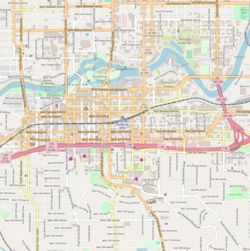This article may need to be rewritten to comply with Wikipedia's quality standards.(July 2020) |
| Post Street Electric Substation | |
|---|---|
 The Post Street Electric Substation viewed from the Spokane River Centennial Trail on the river's north bank | |
| General information | |
| Architectural style | Romanesque Revival |
| Location | Washington |
| Address | 331 N. Post Street Spokane, Washington |
| Country | United States |
| Coordinates | 47°39′40″N117°25′25″W / 47.66112°N 117.4237°W |
| Current tenants | Mobius Science Center |
| Groundbreaking | 1909 |
| Completed | 1910 |
| Landlord | Avista |
| Design and construction | |
| Architect(s) | Kirtland Cutter |
The Post Street Electric Substation (also called the Washington Water Power Building, The Washington Water Power Substation) is an electric substation on the Spokane River next to the Spokane Falls in the city of Spokane, Washington. Built in 1910, the Post Street substation served the needs of the city's growing electric grid as well as the surrounding area. [1] The substation consolidates and delivers power generated by the Upper Falls Power Plant and the Monroe Street Dam hydroelectric plants. [2] The building is one of many contributions to Spokane's downtown area by renowned Pacific Northwest architect Kirtland K. Cutter. [3]


